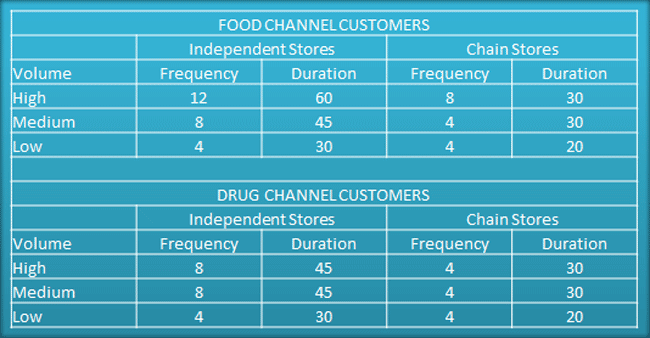Assumptions Into Dollars
During Trade Coverage Planning, the decisions you made during Customer Census & Classification start to take shape in the form of a viable customer call plan and the associated resource requirements. In effect, Trade Coverage Planning is where your criteria are converted into numbers. It may also be the place where you realize some of your earlier decisions may need to be revisited based on the financial implications.
Trade Coverage Planning is the process by which you determine the required effort to call on each customer on an annual basis. To determine effort, it is necessary to apply three numbers to each and every record in your customer database. These three numbers are defined as follow.
- Frequency – How many times (per year) will you call on this customer?
- Duration – How much time (in minutes) will you allocate to each call on this customer?
- Travel – How much time (in minutes) will it take to get to this customer for each call?
For each customer, the frequency and duration will be dependent on the criteria you selected during the Customer Classification process. What you end up with is a very simple formula that looks like this.
- Frequency x (Duration + Travel) = Effort
Enter the Matrix
In order to arrive at this equation for each customer, it is useful to first create a customer matrix based on the attributes you selected during Customer Classification. While this may sound very complicated, we’ll use a simple example to illustrate how it’s done.
Let’s say that your important criteria were volume, channel and chain or independent. Your matrix might look something like this.
You’ll notice that there is no number for travel. This is because travel varies by customer and is, therefore, dependent on factors outside your criteria. Depending on your mapping capabilities, you can create a specific number for each customer based on geo-coding or you can use a blended number based on population density.
Rinse and Repeat As Required
As I mentioned earlier, you may need to reconsider you criteria and repeat this process several times. Your untested criteria may end up with an output of effort that would take 100 sales reps when you only have 50. At that point, you either decide to double your sales force or you reduce the effort for certain customers. I’m guessing you re-figure your effort.
While it may seem inefficient to repeat the process, it is actually part of the benefit and you shouldn’t be discouraged. This is a normal part of the process and it is through the repetition of revisiting your earlier assumptions that you develop a better understanding of the impact of your decisions.
Next Steps
Now that you have a high level, or Macro, view of your customer universe, it is time to bring it down to a territory level. This will require you to break your total customer workload out into sales territories in roughly equal measures. We’ll address this in the next step of the process called Territory Management.

